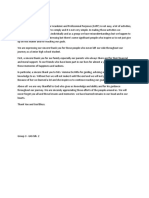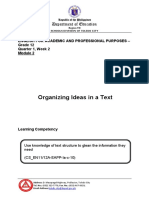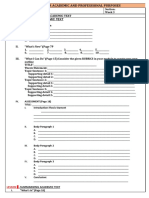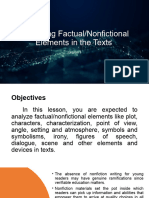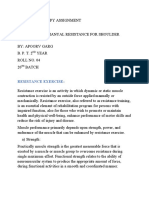7 - Grade 12 - Version of Me 2.0
7 - Grade 12 - Version of Me 2.0
Uploaded by
Gabrelle OgayonCopyright:
Available Formats
7 - Grade 12 - Version of Me 2.0
7 - Grade 12 - Version of Me 2.0
Uploaded by
Gabrelle OgayonOriginal Title
Copyright
Available Formats
Share this document
Did you find this document useful?
Is this content inappropriate?
Copyright:
Available Formats
7 - Grade 12 - Version of Me 2.0
7 - Grade 12 - Version of Me 2.0
Uploaded by
Gabrelle OgayonCopyright:
Available Formats
7 Version of Me 2.
0
Lecturette
“A life that not lived for others is not a life.” – Mother Teresa
The activity “My Hand Version 2.0” has something to do with the individual’s life, the learner’s
future career. The symbolic hand interprets how the individual works. The realization of the learners
chosen career with its work ethics, work values and personality that fits him/her to their career goal.
In the future workplace, it is important for the learner to know the duties and responsibilities of both
employees and employers. (Refer to appendices 1 and 2.)
As the learner experiences education from the school, his interest is in future career progresses.
According to Gestalt, (here and now theory) the experience of the learner has a strong influence that he
could learn and develop his work ethics and work values in the process of learning specific knowledge
and skills towards his chosen career. These are the factors that employers are looking for in an applicant
(learner). Aside from the intellectual part of the learner, another important aspect to consider in the
lifelong career planning is the personality of the learner.
The learner’s personality is an asset not just in the future workplace, but in everyday living. Most
if not all, employers highlight “pleasing personality” from an applicant. Personality is progressive and
developmental. The personality of the learner has been recognized from Module 1 to Module 6. And as
the modules progress, the learners’ personality also improves as it is enhanced in every module. Whether
the learner will decide to be employed, pursue college degree, make a business, or just stop moving
forward to its career advancement, that learner has his own unique personality.
Personality Development essentially means enhancing and grooming one’s outer and inner self to
bring about a positive change to one’s life. Each individual has a distinct persona that can be developed,
polished and refined.
Improving personality and Image is a reproduction or a mental picture of you as seen as others.
People react to you based on the way you present yourself, the way you look, speak and behave. If you
act defensively, you invite attacks. If you act strong and confident, people will respond to you with
respect and deference (Santos, 1984). Some Filipino men and women generally appear overly modest and
shy. Instead of behaving assertively, they behave too submissively, they let the situation appear to be
controlling them.
According to the study of Bencsik, et al., on the Relationship between Motivation and Personality
type, is proven that there is a significant relationship between the known and accepted (attractive) goal of
work its value and employee satisfaction. These relations are factors that reinforce intrinsic motivation.
It is significant to note that the determined aspects (factors) that the learners have considered in
planning for life and career like the goal motivators of the leaner has to be recognized since this factors
that will lead him to his career success that could address to the need of the society or may lead him halt
him from career advancement to meet the need of the society.
Here are some factors that made the learners what they are now: Where are they were from? Are
they from city or from a small town? What were their past experiences, particularly in your family? The
way they respond to people is a result of the way you respond to your family members-especially your
parents in your formative years.
The learner in this module would recognize its motivators as intrinsic and extrinsic motivators in
order to move forward to the next level and even to sustain their lifelong career goals. Intrinsic
motivators are internal variables within the individual give rise to motivation and behavior. Example is
the Maslow’s hierarchy of needs theory.
According to Abraham Maslow’s hierarchy of needs an individual first have to satisfy its basic
Psychological needs (food, shelter and clothing) before the individual takes the second step with it is up
to the next need level which is the Safety and Security, then the need of Belongingness (to love and to be
loved), then the need of Esteem (Self-esteem) and the Self-actualization of which is the highest need of a
person.
While a process motivator emphasizes the nature of the interaction between the individual and the
environment. Examples of valued outcomes in the workplace include pay increases and bonuses,
promotions, time off, new assignments, recognition, and many more.
MODULE 3 1
Grade 12- SHS CGP
Another external motivator to consider which focuses on environmental elements to explain
behavior is the motivator itself. Motivators are more concerned with the actual job itself. For instance
how interesting the work is and how much opportunity it gives for extra responsibility, recognition and
promotion. According to Hernzberg, hygiene factors are factors which 'surround the job' rather than the
job itself. For example a worker will only turn up to work if a business has provided a reasonable level of
pay and safe working conditions but these factors will not make him work harder at his job once he is
there.
To relate the chosen career to the needs of the society, the learner requires to process
himself/herself to change and take the balance in order to fit in and address the need of the society.
The individual in the society is the learner who carries with him/her the factors that will in able him/her
to fit to the needs of the society. The learner’s factors are his/her work values, skills, knowledge, personal
qualities, enhanced personality, work ethics and not limited to friendliness, approachable, genuineness,
warmth and many more. An individual develops and functions within the environmental context.
It is also important to note that as the learners move forward to their career goals they need to
recognize their own core work values and work ethics as well as recognizing other learners work values
and work ethics to work harmoniously as one team (senior high school). The learners will encounter
themselves in the same situation as they exit to work, to have a business, to college, to middle career job
and even if they halt to advance their career. The learners have already learned how to cope and adjust
themselves with the changing career environment.
The process of this module is for the leaners’ goal is to recognize one’s knowledge, skills,
qualities (personality), values (personal values) and work ethics is to get the desired career goal and to
learn how to sustain in his/her desired curriculum exits to be able to address to the need of the community
and to the society as well.
Module 5 mentioned about ROI (Return of Investment) of which is not limited to monetary
investment. The individual learner with its work ethics and work values in the future workplace may
sustain and even be promoted to a higher position. As the quote goes “As long as you’ve got passion,
faith, and are willing to work hard, you can do anything and have anything you want in this world.” –
Unknown
It is important to note that, while learner’s work values play an essential role in their career choice, they
should not consider them in isolation. Learners may also look at their other traits including personality
type, interests, and aptitudes. It is then when learners when l find themselves in a Better Jobs Fit equals
better success and satisfaction that sustain them in the position (Frank Parson, 1908).
Version of Me 2.0 then is a process that the learner will become ready not just in the workplace
but in everyday encounter. The learner then is ready to fit in himself to an organization. Consider the My
Version 2.0 – will now be a marketable person to its lifelong career.
MODULE 3 2
Grade 12- SHS CGP
Name: __________________________________________________________ Date: ______________________
Grade & Section: ______________________________________________
Main Activity:
Procedure:
1. Each learner shall be provided with a piece of paper;
2. Learners observe their two hands and choose which hands represent him/her the most. Is it the
right hand or the left hand?
3. On the bond paper, they trace the hand they chose;
4. Have learners draw symbols:
On the SMALL FINGER: Draw a symbol that represents your present
rack/strand/specialization (Grade 12).
On the RING FINGER: a symbol that represents your Job immersion.
Sample drawing for TVL: Electrical Store, Construction site, Bakery, Beauty House or Salon
and many more
On the MIDDLE FINGER: draw a symbol that represents your career exit (Kolehiyo,
Trabaho, Negosyo and Skills and Development Center).
On the POINT FINGER: Draw a symbol that represents your future job.
On the THUMB: Draw a symbol of your contribution to the society in relation to your future
job (success-like story).
On the PALM AREA: Draw a symbol that represents your Career Motivational Goal;
(strength and sustainability/holding on)
On the WRIST AREA: Draw a symbol that sustains you in the current
track/strand/specialization (connection and sustainability strength and responsibility)
Reflection: Version of Me 2.0 – Progression Sheet
Directions:
1. Learners will have a worksheet of the My Version 2.0 (feet).
2. On the left foot, learners will list things (traits & values) about his/her old self that he/she
needs to change to get ready for the chosen career.
3. On the middle between the left and right feet, the learner will write his/her motivational
mantra to move on. Ex. “Go! Fight! Win!”
4. On the right, learners will list new traits and values to accept, embrace, and improve to
get ready for the chosen career.
MODULE 3 3
Grade 12- SHS CGP
MODULE 3 4
Grade 12- SHS CGP
You might also like
- Eng Chapter 1 To 10Document83 pagesEng Chapter 1 To 10Earone MacamNo ratings yet
- 1 7 Supplier Rohs Audit Checklist Audit Report NoDocument6 pages1 7 Supplier Rohs Audit Checklist Audit Report Noรอคนบนฟ้า ส่งใครมาให้ สักคนNo ratings yet
- Per Dev Developing SelfDocument21 pagesPer Dev Developing SelfArtNo ratings yet
- Me My CareerDocument1 pageMe My CareeriasdfasfsfasfsNo ratings yet
- CGP Portfolio and Attachments For Grade 12Document4 pagesCGP Portfolio and Attachments For Grade 12Mei Jji100% (1)
- EntrepreneurshipDocument1 pageEntrepreneurshipJemel DelosReyes MuñozNo ratings yet
- Portfolio Output No 2 Career Wheel PDFDocument1 pagePortfolio Output No 2 Career Wheel PDFLans IlynNo ratings yet
- Oral-Com-Q1-W7 ModuleDocument10 pagesOral-Com-Q1-W7 Moduledambb hoomannNo ratings yet
- Chapter 11 Oral CommDocument10 pagesChapter 11 Oral CommAriane CloresNo ratings yet
- Aspects of DevelopmentDocument1 pageAspects of DevelopmentJeffrey Valdez Esteron67% (3)
- Lesson 1 Writing Your Job Application Letter: (See Types of Resume)Document14 pagesLesson 1 Writing Your Job Application Letter: (See Types of Resume)Desiree SerranoNo ratings yet
- Unit I Geed 10063 Purposive CommunicationDocument83 pagesUnit I Geed 10063 Purposive Communicationella sakdalanNo ratings yet
- Development of Concepts Writing A Concept PaperDocument14 pagesDevelopment of Concepts Writing A Concept PaperWasdjkasjdkjNo ratings yet
- CareersDocument26 pagesCareersAgnes Sambat DanielsNo ratings yet
- Personal Development 11: Learn ING ActivDocument5 pagesPersonal Development 11: Learn ING ActivJeffrey Bermil SebanesNo ratings yet
- ORAL COMMUNICATION (Fundamentals of Public Speaking)Document6 pagesORAL COMMUNICATION (Fundamentals of Public Speaking)Love LoveNo ratings yet
- Work Immersion - Module 6 - LASDocument6 pagesWork Immersion - Module 6 - LASFermo Gadayan RamosNo ratings yet
- Acknowledgement EappDocument1 pageAcknowledgement EappMarites NuñezNo ratings yet
- Business Plan Presentation Grading Rubric FinalDocument3 pagesBusiness Plan Presentation Grading Rubric FinalMarina EskandrousNo ratings yet
- A Narrative Report On Work Immersion Presented To The Library of LagroDocument16 pagesA Narrative Report On Work Immersion Presented To The Library of LagroJessica Quibral BienNo ratings yet
- Dance Critique SampleDocument2 pagesDance Critique SampleAmee KiNo ratings yet
- What Information CodesDocument1 pageWhat Information Codesjm dumancasNo ratings yet
- Orca Share Media1601452814528 6716979945787847166Document3 pagesOrca Share Media1601452814528 6716979945787847166April Jeannelyn Feniza100% (4)
- Community Based Work ImmersionDocument26 pagesCommunity Based Work ImmersionYvi BenrayNo ratings yet
- PCM - LECTURE 9 - Simulating Philippine WorkplaceDocument10 pagesPCM - LECTURE 9 - Simulating Philippine WorkplaceMikay CredoNo ratings yet
- Worksheet Purcom FinalDocument57 pagesWorksheet Purcom FinalMa.Luzmin CadalinNo ratings yet
- Entrep Module 1 ReviseDocument20 pagesEntrep Module 1 ReviseGhilany Carillo CacdacNo ratings yet
- School Principal Leadership Style and Teachers' Individual Performance Commitment and Review (IPCR) in Antipolo City Senior High SchoolDocument5 pagesSchool Principal Leadership Style and Teachers' Individual Performance Commitment and Review (IPCR) in Antipolo City Senior High SchoolPsychology and Education: A Multidisciplinary JournalNo ratings yet
- Strengths and Weaknesses of A Filipino CharacterDocument36 pagesStrengths and Weaknesses of A Filipino CharacterBryan BalaganNo ratings yet
- WORKIMMERSIONDocument1 pageWORKIMMERSIONcasey luongNo ratings yet
- Lesson 2: WorksheetDocument5 pagesLesson 2: Worksheetember parkNo ratings yet
- Entrep Mind Module 6Document10 pagesEntrep Mind Module 6Wynnie RondonNo ratings yet
- Work Immersion ActivityDocument1 pageWork Immersion ActivityKristine M. Mosquera0% (1)
- Q2 Module 1: My Plan To Exit: Application: Performance TaskDocument1 pageQ2 Module 1: My Plan To Exit: Application: Performance TaskJalen Rose Saldua100% (1)
- Business Finance - Gr.12:: Basic Long-Term Financial ConceptsDocument5 pagesBusiness Finance - Gr.12:: Basic Long-Term Financial ConceptsEianna SencioNo ratings yet
- Enrichment Activity: Direction: Take A Look at Your Own Self-Concept and Answer The Following Self-Concept Inventory inDocument4 pagesEnrichment Activity: Direction: Take A Look at Your Own Self-Concept and Answer The Following Self-Concept Inventory inCharles Mañalac AguilarNo ratings yet
- TLEG 10 Q2Module 8 HWM Evaluate Clients SatisfactionLanie C. CanoDocument10 pagesTLEG 10 Q2Module 8 HWM Evaluate Clients SatisfactionLanie C. CanoKatrina F. Sernal100% (1)
- Module 6Document27 pagesModule 6Danielle Ann OreaNo ratings yet
- Developing Whole PersonDocument10 pagesDeveloping Whole Personarun sivaNo ratings yet
- Code of Ethics in Business Organizations: Grade 12Document9 pagesCode of Ethics in Business Organizations: Grade 12Joan Marie SalayogNo ratings yet
- PHILOSOPHYDocument11 pagesPHILOSOPHYCherry Doong CuantiosoNo ratings yet
- Week 2Document7 pagesWeek 2ZsazsaNo ratings yet
- EAPP-12 Q1 Mod6 Week6Document17 pagesEAPP-12 Q1 Mod6 Week6Pragas FroyNo ratings yet
- Mock Interview Rubric - Culminating ActivityDocument1 pageMock Interview Rubric - Culminating ActivityMIRIAM DUMLAONo ratings yet
- Student Activity Sheet 1Document33 pagesStudent Activity Sheet 1Ezekiel Bea AdayaNo ratings yet
- Product Conceptualization and The Creative MindDocument1 pageProduct Conceptualization and The Creative MindWalter OrpillaNo ratings yet
- Tatay Na Si Totoy Final Paper For Book BindDocument123 pagesTatay Na Si Totoy Final Paper For Book BindAbegail MontanezNo ratings yet
- DigitalAgeEducation Top 10 QuestionsDocument53 pagesDigitalAgeEducation Top 10 QuestionsSauravNo ratings yet
- Organiz Rganizing Ideas in A Text Text: D Department of EducationDocument16 pagesOrganiz Rganizing Ideas in A Text Text: D Department of EducationAmytheez Camomot100% (2)
- What I Have Learned: Activity 3 My Own Guide in Choosing A CareerDocument3 pagesWhat I Have Learned: Activity 3 My Own Guide in Choosing A CareerJonrheym RemegiaNo ratings yet
- WHLP Personal Development Week 8Document2 pagesWHLP Personal Development Week 8Xazerco Lax100% (1)
- EAPP ReadingActivity Questions and InstructionsDocument3 pagesEAPP ReadingActivity Questions and Instructionsՙՙՙՙ ՙՙՙՙ0% (2)
- MODULE 1: Week 2 The Principles of Marketing Lesson 2: Needs, Wants and DemandsDocument7 pagesMODULE 1: Week 2 The Principles of Marketing Lesson 2: Needs, Wants and DemandsWilliam Laguisma Bona100% (1)
- Instructions: Skim The Following Job Advertisements. Then, Scan The Text That Follows andDocument2 pagesInstructions: Skim The Following Job Advertisements. Then, Scan The Text That Follows andVasu WinNo ratings yet
- NSTP1 Module 4 Citizenship ValuesDocument84 pagesNSTP1 Module 4 Citizenship ValuesKristel BelgicaNo ratings yet
- 14 What Drives AttractionDocument12 pages14 What Drives AttractionJay L ParallagNo ratings yet
- To The LearnersDocument14 pagesTo The LearnersJessaLorenTamboTampoyaNo ratings yet
- Media MotivesDocument9 pagesMedia MotivesGLAISA C. BAUTISTANo ratings yet
- Career Guidance CG12 Module 7Document7 pagesCareer Guidance CG12 Module 7claire dumpNo ratings yet
- HRM Career DevelopmentDocument26 pagesHRM Career DevelopmentSuman PoudelNo ratings yet
- Week 7Document52 pagesWeek 7Gabrelle OgayonNo ratings yet
- Sdoquezon Adm SHS12 C Mil M5Document20 pagesSdoquezon Adm SHS12 C Mil M5Gabrelle OgayonNo ratings yet
- W1 Introduction To Philosophy Leap PDFDocument4 pagesW1 Introduction To Philosophy Leap PDFGabrelle OgayonNo ratings yet
- WEEK-3: Media and Information LiteracyDocument23 pagesWEEK-3: Media and Information LiteracyGabrelle OgayonNo ratings yet
- Road To The Right ChoiceDocument4 pagesRoad To The Right ChoiceGabrelle OgayonNo ratings yet
- Sdoquezon Adm SHS12 C Mil M1Document17 pagesSdoquezon Adm SHS12 C Mil M1Gabrelle OgayonNo ratings yet
- 8 - Grade 12 - Ready To Take Off!Document4 pages8 - Grade 12 - Ready To Take Off!Gabrelle OgayonNo ratings yet
- PR1 WK1Document5 pagesPR1 WK1Gabrelle OgayonNo ratings yet
- Additional Activity:: Modular LearningDocument2 pagesAdditional Activity:: Modular LearningGabrelle OgayonNo ratings yet
- Hope and Elevations On The Minnesota Multiphasic Personality InventoryDocument5 pagesHope and Elevations On The Minnesota Multiphasic Personality InventoryGabrelle OgayonNo ratings yet
- Hopee 33Document11 pagesHopee 33Gabrelle OgayonNo ratings yet
- Activity Sheet Q1wk 7 OCCDocument6 pagesActivity Sheet Q1wk 7 OCCGabrelle OgayonNo ratings yet
- Trends, Networks, and Critical Thinking in The 21st CenturyDocument22 pagesTrends, Networks, and Critical Thinking in The 21st CenturyGabrelle Ogayon100% (1)
- English For Academic and Professional Purposes: Lesson 1Document6 pagesEnglish For Academic and Professional Purposes: Lesson 1Gabrelle OgayonNo ratings yet
- Week 1 - Mil Answer SheetDocument1 pageWeek 1 - Mil Answer SheetGabrelle OgayonNo ratings yet
- Week 2 Mil Answer SheetDocument1 pageWeek 2 Mil Answer SheetGabrelle OgayonNo ratings yet
- Activity-Sheet-Q2 WK-1-OCCDocument6 pagesActivity-Sheet-Q2 WK-1-OCCGabrelle OgayonNo ratings yet
- Sasmo Infopack-2023Document22 pagesSasmo Infopack-2023Sunny Six100% (1)
- How-To-Choose-Sampling-Techniques-For-Evaluations ReadingDocument4 pagesHow-To-Choose-Sampling-Techniques-For-Evaluations ReadingSolo JemNo ratings yet
- LT # 1 (Composition Stoichiometry) & Reaction StoichiometryDocument3 pagesLT # 1 (Composition Stoichiometry) & Reaction StoichiometryANONNNo ratings yet
- Intensif Utbk 4Document9 pagesIntensif Utbk 4verratweexNo ratings yet
- Lecture 4Document30 pagesLecture 4irayyn7No ratings yet
- Lesson 3 Analyzing Factual NonFictional Elements in The TextDocument9 pagesLesson 3 Analyzing Factual NonFictional Elements in The Textluna.amaltheatiaraNo ratings yet
- Chapter-4 Materials and MethodsDocument15 pagesChapter-4 Materials and MethodsSunil ChaudharyNo ratings yet
- Advanced Numerical Analysis: Data Interpolation and SmoothingDocument26 pagesAdvanced Numerical Analysis: Data Interpolation and SmoothingBishnu LamichhaneNo ratings yet
- Combined IB Measurement SL Prac Qs 0910Document19 pagesCombined IB Measurement SL Prac Qs 0910Demian VeNo ratings yet
- Level K - Student Leadership Guide Home CompanionDocument38 pagesLevel K - Student Leadership Guide Home CompanionAraoye AbdulwaheedNo ratings yet
- PNE 113 TestDocument9 pagesPNE 113 TestkaterinechiquillaNo ratings yet
- English WritingDocument3 pagesEnglish Writingthe untamedNo ratings yet
- Axial Piston Pump Variable Displacement Bosch Rexroth A4VSO 1421347275 PDFDocument60 pagesAxial Piston Pump Variable Displacement Bosch Rexroth A4VSO 1421347275 PDFEduardo Cramer100% (4)
- IAS - Physics - SB1 - Practs - CP2 - Student SheetDocument2 pagesIAS - Physics - SB1 - Practs - CP2 - Student SheetBryan YeohNo ratings yet
- Exercise Therapy AssignmentDocument13 pagesExercise Therapy AssignmentApoorvNo ratings yet
- TL Biến Tần AlphaDocument51 pagesTL Biến Tần AlphaDương Quốc TháiNo ratings yet
- REVIEW PAPER The Impact of Information System Audit Input Levels On Audit Quality: Evidence KoreaDocument13 pagesREVIEW PAPER The Impact of Information System Audit Input Levels On Audit Quality: Evidence KoreaAlya AzzahraNo ratings yet
- Contoh Soal PG Bahasa Inggris Kelas XI Semester 1 K13 Beserta JawabanDocument12 pagesContoh Soal PG Bahasa Inggris Kelas XI Semester 1 K13 Beserta JawabanIntan Wahyu DhamayantiNo ratings yet
- Ermysted's Grammar School: September 2022Document11 pagesErmysted's Grammar School: September 2022Johan SamangunNo ratings yet
- Error TerrorDocument1 pageError TerrorIrina VadanNo ratings yet
- IBC 2006 SEISMIC PARAMETER For StaadDocument22 pagesIBC 2006 SEISMIC PARAMETER For Staadutoy032367No ratings yet
- Student Edge January 2024 DigitalDocument20 pagesStudent Edge January 2024 DigitalVinet LoboNo ratings yet
- Semi-Detailed Lesson PlanDocument3 pagesSemi-Detailed Lesson PlanMariel Azon100% (4)
- Efectis Group Presentation 2012Document11 pagesEfectis Group Presentation 2012octy-sanNo ratings yet
- 3M Spacing GuideDocument2 pages3M Spacing Guideadam.l.whippleNo ratings yet
- Van Maanen ConfessionalDocument15 pagesVan Maanen ConfessionalNejua NahualtNo ratings yet
- AIMER - Mathematical Seminar Contest - 2022Document6 pagesAIMER - Mathematical Seminar Contest - 2022Trash SinghNo ratings yet
- MAS72x EN 04 Install StartupDocument28 pagesMAS72x EN 04 Install StartupRodrigoNo ratings yet
- Week 3Document15 pagesWeek 3Mike Coronel ToralesNo ratings yet

















